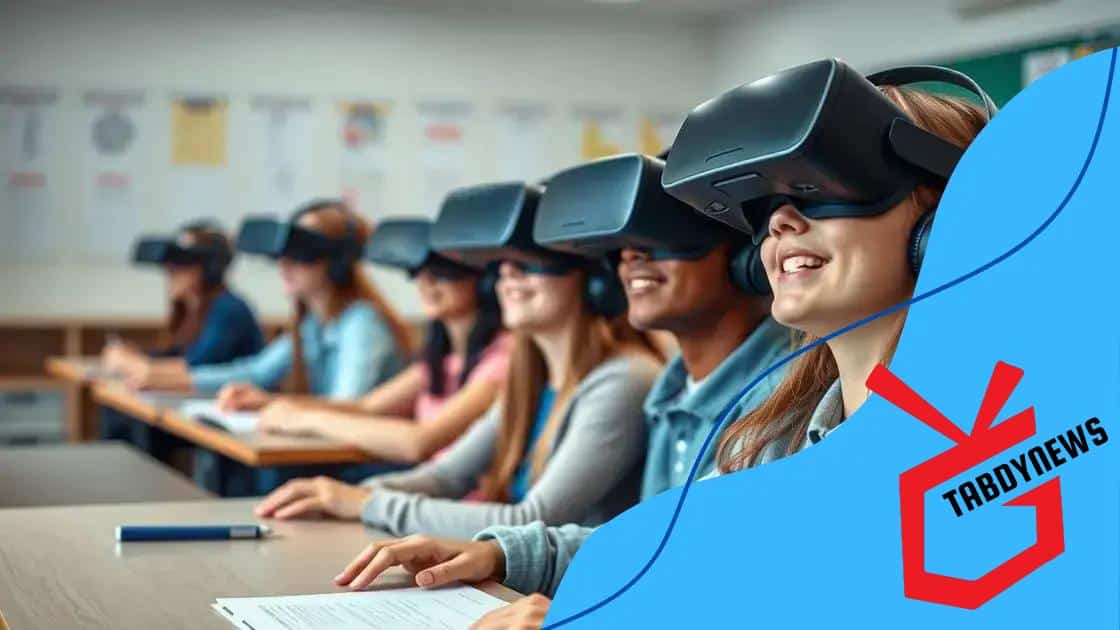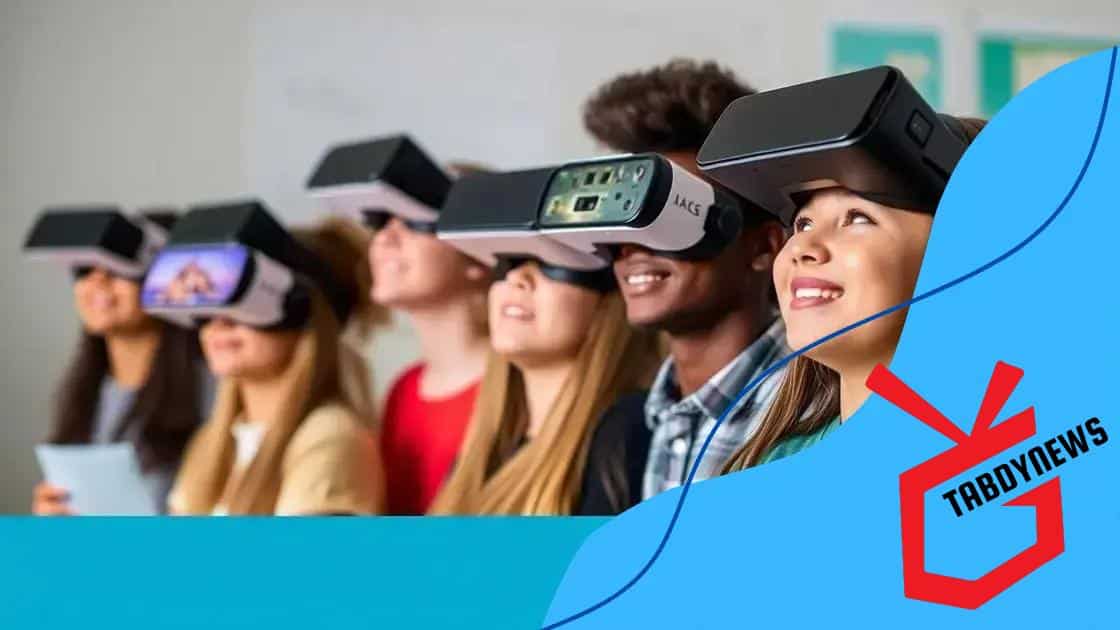Virtual reality for immersive education transforms learning

Virtual reality for immersive education enhances student engagement and learning retention by providing interactive experiences while facing challenges like cost and technical issues.
Virtual reality for immersive education is reshaping the way students learn by providing engaging experiences that traditional methods simply can’t match. Imagine stepping inside a historical event or exploring the human body from the inside out—these are just a taste of what VR can offer in the classroom.
Understanding virtual reality in education
Understanding virtual reality in education opens new doors for interactive learning experiences. This technology is not just about visuals; it truly immerses students in a new world where they can learn effectively and enjoyably.
What is Virtual Reality?
Virtual reality (VR) uses technology to create a simulated environment. Users can interact with this environment through hardware like headsets and motion controllers. In an educational setting, VR can bring lessons to life, making complex subjects easier to understand.
Benefits of Virtual Reality in Education
Using virtual reality in the classroom has several advantages:
- Enhanced Engagement: Students are more likely to pay attention when they are actively involved.
- Real-Life Applications: VR can simulate real-world scenarios, providing practical learning experiences.
- Diverse Learning Styles: VR caters to different learners, making education more inclusive.
Furthermore, students often retain information better when they experience it firsthand. Picture learning about the solar system by virtually flying through space. This type of interactive lesson helps create memorable educational moments.
Real-World Applications of VR
Many schools and universities are now exploring virtual reality. For example:
- Medical students practice surgeries in a virtual setting, which is safer and less stressful.
- History classes can take virtual field trips to historical sites.
- Language learners can immerse themselves in different cultures without leaving the classroom.
These real-world applications showcase how versatile VR can be in enhancing educational experiences. The integration of this technology not only supports learning but also fosters creativity and innovation.
Benefits of immersive experiences for learners
The benefits of immersive experiences for learners are significant and transformative. Engaging fully with content leads to deeper understanding and retention of information.
Increased Engagement
When students participate in immersive learning, they are more engaged. Instead of passively receiving information, they become active participants. This active involvement encourages curiosity and motivates students to explore topics further.
Enhanced Retention
Immersive experiences enhance memory retention. Students are more likely to remember concepts learned through hands-on experiences. For example, a student learning about marine biology can explore an underwater ecosystem virtually, making the learning experience memorable and exciting.
Development of Critical Skills
Immersive learning promotes the development of critical thinking and problem-solving skills. Students often face challenges in virtual environments that require them to think critically and make decisions. This real-time problem-solving boosts their confidence and preparation for real-world applications.
Accessibility and Inclusivity
Furthermore, immersive experiences can make learning more accessible for all students. These methods can cater to different learning styles, ensuring each student finds a way to connect with the material. This inclusivity fosters a supportive learning environment where diversity in learning is embraced.
In particular, students with learning difficulties benefit greatly from immersive methods. They can explore and learn at their own pace, enabling a personalized education experience that traditional classrooms might not offer.
Examples of virtual reality applications

There are many exciting examples of virtual reality applications in education today. These applications showcase how this technology can transform learning experiences and make them more engaging.
Science Exploration
In science classes, students can use VR to explore complex concepts. For instance, they can take a virtual tour of the human body to see how different systems work together. This type of immersive experience provides a unique understanding of topics that are hard to grasp through books alone.
Historical Simulations
Another popular use of VR is in history education. Students can virtually visit historical events and places, such as the signing of the Declaration of Independence or the ancient ruins of Rome. By experiencing these events firsthand, learners develop a deeper connection to the material and can better appreciate historical contexts.
- Virtual field trips to famous landmarks.
- Simulated experiences of significant historical events.
- Role-playing as historical figures to understand their perspectives.
This method allows students to engage with history dynamically, rather than just reading about it in textbooks.
Language Learning
For language learners, VR offers opportunities to practice speaking with virtual natives. Immersing oneself in a virtual environment can reduce anxiety and build confidence when speaking a new language. Students can navigate scenarios like ordering food in a restaurant or asking for directions, which makes the learning process practical and relevant.
Architectural Design and Engineering
In fields like architecture and engineering, VR helps students visualize their designs in a 3D space. They can walk through their projects before they are built, making adjustments as needed. This ability to see and interact with their designs enhances learning significantly.
These examples of virtual reality applications illustrate how diverse and impactful VR can be in education. As this technology evolves, it continues to provide more innovative ways to engage and educate learners.
Challenges and limitations of virtual reality
Despite the exciting possibilities, there are several challenges and limitations of virtual reality in education that educators and institutions must consider.
Cost and Accessibility
One major challenge is the cost of VR technology. High-quality headsets and software can be expensive, which can limit access for some schools. This high price tag may restrict adoption, especially in underfunded educational systems. Additionally, not all students have access to necessary hardware at home, creating a digital divide.
Technical Issues
Technical issues can also hinder the use of VR. Software can crash or lag, disrupting the learning experience. If teachers cannot rely on VR technology to function smoothly, it may discourage its use in the classroom. Regular maintenance and updates are essential but can be time-consuming and costly.
Learning Curve
There is a learning curve associated with using virtual reality. Both teachers and students need training to use VR effectively. Some educators may feel overwhelmed by the technology and hesitant to implement it in their teaching methods. This reluctance can stall the integration of immersive learning experiences.
Physical Discomfort
Another limitation involves physical discomfort when using VR headsets. Prolonged use can lead to eye strain, headaches, or motion sickness for some users. These physical reactions can limit how long students can engage with VR-based lessons, affecting the overall effectiveness of the technology.
Moreover, safety concerns arise when students are immersed in virtual environments. Attention must be given to ensure that students do not inadvertently harm themselves while moving around. Creating safe physical spaces for VR is essential for successful experiences.
These challenges and limitations of virtual reality highlight the need for careful planning and consideration before implementation in educational settings. While VR has the potential to revolutionize education, addressing these issues is critical for maximizing its benefits.
Future trends in virtual reality for education
The future trends in virtual reality for education promise to further revolutionize how students learn and engage with content. As technology evolves, we can expect more innovative applications of VR in educational settings.
Advances in Technology
As VR technology continues to improve, devices are becoming more affordable and user-friendly. Future headsets may be lighter, eliminating discomfort during long use. Additionally, improved graphics will make virtual environments even more immersive and realistic, attracting more users.
Integration with Artificial Intelligence
Another exciting trend is the integration of artificial intelligence (AI) with VR. AI can personalize learning experiences, adapting lessons to meet individual student needs. For instance, an AI-powered VR program could assess a student’s progress in real time and adjust the difficulty of tasks accordingly.
- AI can create more engaging content dynamically.
- Learning assessments can become more efficient.
- Programs can accommodate various learning styles smoothly.
This blend of AI and VR has the potential to create tailored educational paths for each student, enhancing learning outcomes.
Collaborative Learning Environments
Future VR technology is likely to facilitate collaborative learning. Students from different locations can join the same virtual classroom. They can work together on projects or participate in discussions, benefiting from diverse perspectives while building teamwork skills.
These future trends in virtual reality for education highlight the potential of VR to reshape learning. As educators adopt new technologies, the possibilities for engaging and effective education will expand significantly.
FAQ – Frequently Asked Questions about Virtual Reality in Education
What are the main benefits of using virtual reality in education?
Virtual reality enhances engagement, allows for immersive learning experiences, and helps students better retain information.
What challenges are associated with implementing VR in classrooms?
Challenges include high costs, technical issues, the need for teacher training, and potential physical discomfort for users.
How can AI be integrated into virtual reality for education?
AI can personalize learning by adapting VR experiences to meet individual student needs, enhancing engagement and effectiveness.
What future trends can we expect for VR in education?
Future trends include advancements in technology, increased collaboration among students through VR, and further integration with AI for tailored educational experiences.





